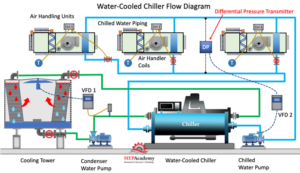An AHU itself does not use chilled water directly. However, it is a common component in central air conditioning systems that utilize chilled water for cooling. Here’s how it works:
- Chiller: A chiller is a separate piece of equipment that acts like a refrigerator for buildings. It uses a refrigerant cycle to produce chilled water.
- AHU with cooling coil: The AHU typically has a heat exchanger called a cooling coil within it.
- Chilled water circulation: The chilled water produced by the chiller is pumped through the cooling coil in the AHU.
- Air cooling: As warm room air is drawn or pushed (depending on the AHU configuration) through the AHU, it passes over the cold cooling coil. This transfers heat from the air to the chilled water, cooling the air.
- Conditioned air distribution: The cooled air is then distributed throughout the building through a network of ducts and vents.
Therefore, while the AHU doesn’t directly “use” chilled water, it plays a crucial role in the system by facilitating the transfer of coolth from the chilled water to the air being circulated.
AHUs Can Have Other Cooling Methods:
It’s important to note that AHUs aren’t limited to chilled water for cooling. They can also be equipped with:
-
Direct Expansion Coils: These coils use refrigerant directly, similar to how a window AC unit functions.
-
Hydronic Heating Coils: While chilled water coils cool, hot water coils can be used in AHUs for heating buildings.
The choice of cooling method depends on factors like building size, efficiency considerations, and initial installation costs. However, chilled water systems are a popular selection due to their ability to cool large buildings efficiently.

Chillers and Air Handling Units
VISIT OUR WEBSITE:https://vipulac.in/
CONTACT NO: 8000092000
